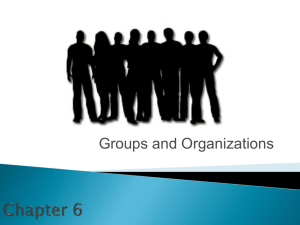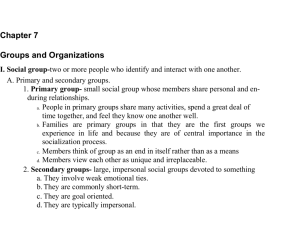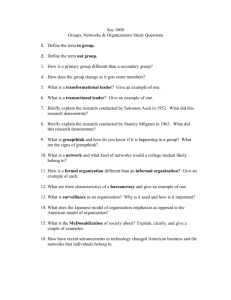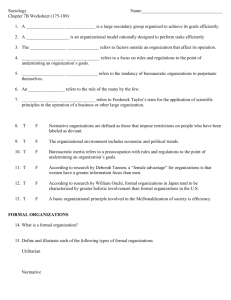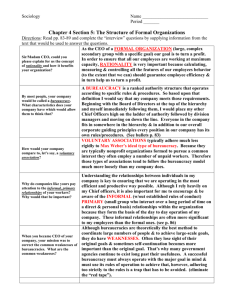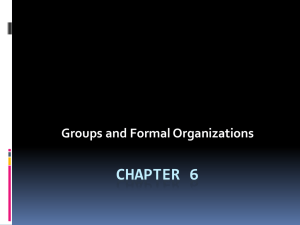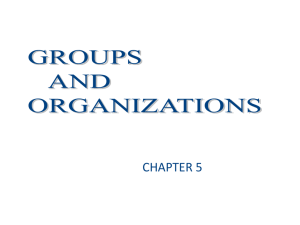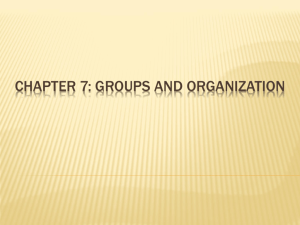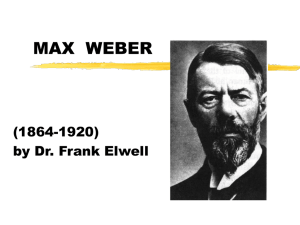Shepard 10e PPTs chapter 6_web
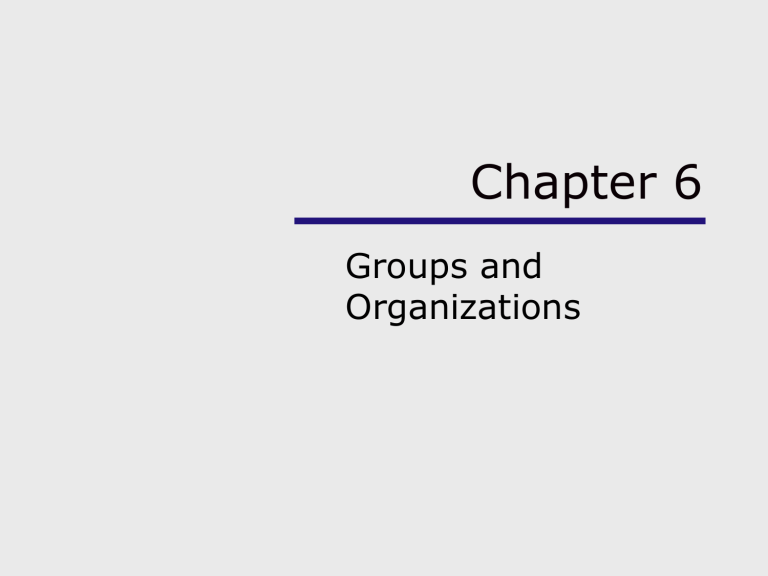
Chapter 6
Groups and
Organizations
Chapter Outline
Concept of the Group
Types of Groups
Social Interaction in Groups
Formal Organizations
Dynamics of Formal Organizations
Questions for Consideration
How does group membership define one’s status?
What are the aspects of interaction in the groups that are identified in this video?
What is the importance of social cohesion?
Groups –
Social Relationships
Members of groups:
Interact and/or are in contact with one another
Share culture or some ways of thinking, feeling, and behaving
Consider one another’s behavior
Have some common interests and goals
Social Relationships
The following ways of togetherness should be distinguished from a group. They are not groups but do describe ways of being together.
Category – people who share a social characteristic; all people in a category do not interact with one another (e.g., women, college students).
Aggregate – people who are at the same place at the same time, but interact very little if at all
(e.g., waiting in line at the grocery store, people on a bus).
Types of Groups
Two principal types of groups:
primary and secondary.
Most groups sit at different points along a continuum from primary to secondary.
Primary Groups
Primary Groups – people who are emotionally close, know one another well, and seek one another’s company. Characterized by relationships that are intimate, personal, caring and fulfilling.
Conditions that Promote
Primary Groups
Secondary Groups
Secondary Groups – people come together to accomplish a specific purpose.
These groups are impersonal and goal oriented. Involves only some of the segments of its members’ lives.
Many secondary groups are settings for primary relationships and then primary groups are offshoots of a secondary group.
Characteristics of Primary and Secondary Groups
Nature of
Relationship
Primary
Close social interaction
Function Emotional support, socialization
Examples Family, soldiers, street gang
Secondary
Impersonal
Help achieve group goals
Class, team, law firm
Reference Groups
Individuals use various groups to evaluate themselves and to acquire attitudes, beliefs, values, and norms.
These groups are our reference groups.
You may or may not be a member.
You assess self in terms of their standards, etc.
Includes families, teachers, doctors, political leaders, college Greek organizations, sports teams.
In-Groups & Out-Groups
In-groups – the group within which one has membership. Encourages intense identification and loyalty.
Out-groups – groups of which one is not a member. The in-group members feel opposition and competition with outgroups and their members.
It is from membership in these groups that people divide into “we” and “they”.
Group Boundaries
Formation and maintenance of ingroups and out-groups depends on the establishment and protection of group boundaries.
Clashes with outsiders; symbols, certain words and rituals, etc. are all used to help maintain group boundaries.
Social Network
Social network – a web of social relationships that joins a person to other people and groups.
Links a person with a wide variety of individuals and groups.
Provides a sense of belonging and social support and help in the job market.
Functions of Social
Networks
Provide a sense of belonging.
Furnish support in the form of help and advice.
Provide a useful tool for entering the labor market.
Five Types of Social
Interaction in Groups
Cooperation – a form of interaction in which individuals or groups combine their efforts to reach some common goal.
Conflict – when people work against each other to obtain a larger share of the rewards. Many times defeating the opponent becomes more important than achieving the goal and may bring more joy than winning the prize.
Five Types of Social
Interaction in Groups –
Cont.
Social Exchange – a type of social interaction in which one person voluntarily does something for another, expecting a reward in return. The basis is reciprocity.
Coercion – an individual or group compels others to behave in certain ways. Central element is domination.
Conformity – behavior matching group expectations. We adapt our behavior to fit the behavior of those around us.
Social Interaction
The Business of Groups
Most groups are designed to accomplish certain tasks, which can range from planning leisure activities to manufacturing a product.
Robert Bales (1950) developed
“interaction process analysis” to classify group interactions into several categories.
He also stated there are two basic problems that must be solved by any social system.
Two Problems of Groups
Instrumental Problems – those that are directly related to achieving the goals of the group.
Social-emotional Problems – problems involving individual satisfaction, disagreements, and other related matters that inevitably arise whenever individuals try to coordinate their activities.
Leadership in Groups
Ralph Stogdill has suggested that leaders will/should have the following combination of traits:
Strong drive for responsibility & task completion.
Persistence in pursuit of goals.
Venturesomeness and originality in problem solving
Drive to exercise initiative in social situations.
Self-confidence and sense of personal identity.
Willingness to accept consequences of decision and action.
Readiness to absorb interpersonal stress.
Willingness to tolerate frustration and delay.
Ability to influence other persons’ behavior.
Capacity to structure social interaction systems.
Decisions and Groups
In some situations, group decisions can be shown to be superior to the decisions made by individuals.
Yet, group pressure can also harm the quality of decisions by leading to excessive conformity and loss of individuality.
The tendency to conform to group pressure has been dramatically illustrated in a classic experiment by Solomon Asch (1955).
Asch Experiment
Participants publicly denied their own senses in order not to deviate from majority opinion.
Numerous groups of male college students were assembled and asked to compare the length of lines on two cards.
Under group pressure, the “naïve” subject went along with the majority’s wrong opinion over 1/3 of the time.
Cards for Asch’s
Experiments
Groupthink
A situation in which pressures toward uniformity discourage members of the group from expressing their reservations about group decisions.
Examples: Buildup to the invasion of Iraq in
2003; Kennedy administration decision to launch the Bay of Pigs invasion.
Groupthink can be avoided only when leaders or group members make a conscious effort to see that all group members participate actively and that disagreement is tolerated.
Questions for Consideration
What is bystander apathy?
Are there similarities between bystander apathy and groupthink?
In the absence of clearly defined responsibility, what happens?
Formal Organizations
Formal organizations - A type of secondary group that is deliberately created to achieve one or more goals.
The change from preindustrial to industrial society lends itself to the establishment of more and more formal organizations.
Citizens of modern society have become highly dependent on large organizations.
Bureaucracy
Most formal organizations are bureaucracies.
Bureaucracy – formal organization based on rationality and efficiency.
Have proved to be an efficient form of organization for industrial society.
Max Weber first analyzed the nature of bureaucracy.
Major Characteristics of
Bureaucracy
A division of labor based on the principle of specialization.
A hierarchy of authority.
Organizational affairs are based on a system of rules and procedures.
Members of the organization maintain written records of their organizational activities.
Statuses in the organization, especially managerial ones, are considered fulltime jobs.
Major Characteristics of
Bureaucracy
Relationships within the organization are impersonal, devoid of favoritism.
Employees of bureaucratic organizations do not own their positions.
University Organization
Chart
Problems with Bureaucracy
Dehumanizing social environment (iron cage
of rationality)
Wastefulness
“Parkinson’s Law” – work always expands to fill the time available for its completion
“Peter principle” – individuals rise to their level of incompetence (moving into higher positions)
Goal displacement
Trained incapacity
Questions for Consideration
What is meant by
“McDonaldization”?
How does Ritzer’s idea of
McDonaldization relate to Weber’s
“iron cage of rationality”?
Where else in our culture do you see
McDonaldization occurring?
Differences Among Formal
Organizations
Normative Organizations – members are free to join, considered voluntary organizations; they have shared understandings that provide an important basis for coordination of members’ activities (e.g., churches, political parties, universities).
Coercive Organizations – people are forced to join (e.g., camps, prisons, elementary schools).
Utilitarian Organizations – people join them because of the benefits they derive from membership (e.g., work, professional firms).
Informal Organization
Informal organization – a group in which personal relationships are guided by unofficial norms, rituals, and sentiments that are not part of the formal organization.
Usually form spontaneously based on common interests and personal relationships.
Iron Law of Oligarchy
Formulated by Robert Michels, the
iron law of oligarchy states that power tends to become increasingly concentrated in the hands of a few members of any organization.
Those in power want to remain in power.
Politics is a prime example.
Organization and Oligarchy
Three organizational factors encourage oligarchy:
Organizations need a hierarchy of authority to delegate decision making.
Advantages held by leaders at the top of the hierarchy allow them to consolidate their power.
Encouraged by the characteristics of the followers. Nonelites believe that their leaders are more articulate, etc.
Race, Ethnicity, Gender, and
Social Class in Organizations
Power is concentrated in relatively few positions at the top and are generally held by white men from higher social classes.
Glass ceiling – reflects that fact that so few women and minorities get promoted to the more powerful
(higher) positions.
Interorganizational
Relationships
This term refers to a pattern of interaction among authorized representatives of two or more formally independent organizations.
Entered into primarily for a need for resources possessed by other organizations and an awareness of the availability of those resources in other organizations contribute to the formation of interorganizational relationships.
Interorganizational Relationships
Involving the Police
Questions for Consideration
What might be some of the outside resources needed by the police that contribute to these various relationships?
What is it that makes some of these relationships cooperative, conflictual, and neutral?
